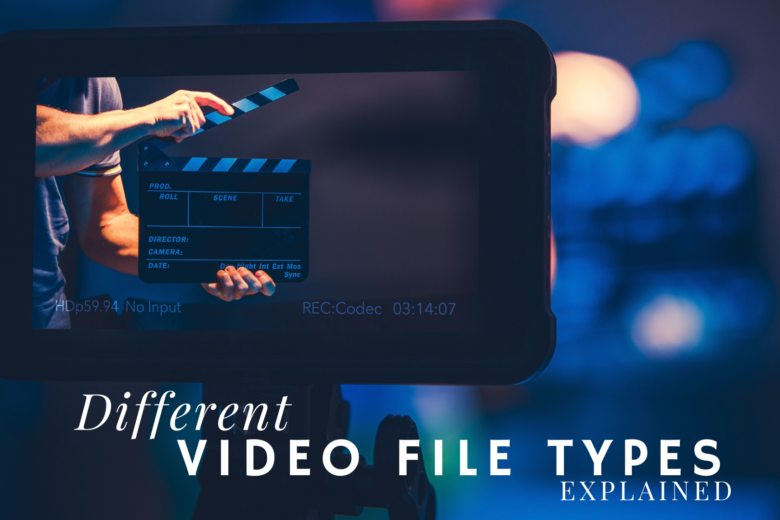Video File Types: An In-Depth Guide
In this digital age, most of the content we consume is in the form of video. Whether you’re watching videos to be entertained or inspired, they have become a primary and vital source of information.
Video has evolved with today’s usage of Youtube, Facebook, and other media channels. If you’re a developer, professional videographer, or a simple fan of video, knowing the different types of video formats is essential.
It’s also important to understand the various video file types when you need to change your video format — for example, to upload a clip to the internet or digitize an aging video. You should know what format to choose so your video is properly formatted, appears in the highest quality, and can best reach its target audience.
This article will discuss video file types, common formats, and how to choose the right one for your needs.
What is a Video Codec?
Before covering the different video file types, you should understand what a video codec is.
A video codec is a type of hardware or software used to compress and decompress digital video. Doing this makes video file sizes smaller and the distribution and storage of your videos easier.
Codecs also optimize video files for playback. An algorithm is used to compress video files into a “container format.” Once the video files are transferred, the codec decompresses them, making them optimal for viewing.
Without video codecs, we would be unable to stream media. Codec technology is critical to the process of video streaming and an intricate component in creating, editing, and putting out any digital video.

What are Video File Formats?
Let’s first define what a video file format is to better understand the various formats available.
We know a video is a series of moving pictures paired with audio and formatted to play at a certain speed. Since videos contain two elements — image and audio — the files can be enormous, making them difficult to share.
This is where codecs come in. This software will compress or decompress the data. It will also encode or decode the data. As mentioned above, all of this is stored in a container format known as a video file format.
There are a few different video file formats, the most common being MP4, AVI, and MOV. These video file types are typically used for different purposes: MP4 is often used for streaming video online, while AVI is more commonly used for downloading and watching videos offline. MOV files are usually used for storing high-quality video footage.
When it comes to video file formats, there are a few things to keep in mind. Different file formats can have different levels of quality, so you must choose the proper format for your needs.
For example, if you’re looking to download and watch a movie offline, you’ll want to choose a format with a high level of quality, like MOV. On the other hand, if you’re just streaming a video online, you can select a lower-quality format like MP4.
Finally, it’s also worth noting that some file formats are better suited for certain devices. For example, MP4 files can be played on most computers and smartphones, while MOV files are most compatible with Apple devices like the iPhone and iPad. So, if you’re planning on watching a video on your phone or tablet, you’ll want to ensure it’s in a film file format compatible with your device.

What are the Most Common Video Formats?
Many video formats are available, and choosing the right one largely depends on how you want to balance quality and file size. With that in mind, let’s take a closer look at some of the most common video file formats and their associated benefits.
- MP4, developed in 2001 by the Motion Picture Experts Group, is compatible with most video software and offers an almost lossless quality. With the ability to keep the quality high while keeping the file size small, this file format is widely used. Youtube, Facebook, and many streaming sites format their videos in MP4. If you convert your video into MP4, it is the surest way to know your video will be compatible down the line.
- AVI (Audio Visual Interleave) is one of the oldest video formats. It was developed by Microsoft and released in 1992. As AVI is older than other formats, it is compatible with almost all video software, and the quality of the AVI format is excellent, making it suitable for storing videos. However, because of its dated format, it doesn’t support compression. As a result, AVI is not a suitable option for use on the internet.
- WebM is the most common video format in modern browsers. Developed by On2 and Xiph in 2011 and sponsored by Google. WebM is an open source format used for commercial and non-commercial uses. With support on most modern browsers, the file size is small, and buffering negligible. With streaming and video platforms increasing, WebM has declined in use but is still supported in Google Chrome, Firefox, Opera, and VLC. (Note: WebM isn’t supported on Apple Software.)
- Windows Media Video, WVM, was developed in 1999 by Microsoft for usage with online video streaming. WVM has small file sizes for easy use and quick downloads on the internet. However, the video quality isn’t great because of the small file size. As a result, the video file type has fallen out of use.
- MOV is a file extension for videos developed by Apple in 1998. It is one of the more popular video formats. Similar to MP4, MOV supports quality audio, video, image, and text. Compared to the file size of MP4, though, it is much larger. Even so, the quality of MOV makes it popular among professionals in editing. Because MOV is an Apple product, it is not compatible with every software but is convertible to the other common video formats.
- Flash video format, better known as FLV, is a video format developed by Adobe Systems. FLV is commonly used on Youtube but is not supported on IOS. With a plug-in added to your browser, you can play flash videos quickly and easily. The usage of flash formats has been declining since it ended support for IOS. (Note: FLV can be used on legacy systems.)
- Advanced Video Coding High Definition, or AVCHD, is supported by Windows Media Player and can be used on memory sticks (flash drives) and removable storage. Sony and Panasonic designed it in 2006 for primary use on camcorders. As AVCHD 2.0 is a relatively recent release, this format can also support HD and 3D videos.
- MKV is a royal free video format and is one of the most common video file types. Developed in 2002 by Matroska, a French non-profit organization. MKV is used for TV shows, movies, and short films. It is considered future-proof as it stores audio, video, and subtitle in separate tracks yet all in the same file. Adobe Premiere Pro is known to use MKV when editing, which highlights how MKV can work with modern codecs.
- MPEG-2 is used for burning videos onto discs. It lacks compatibility and quality compared to most modern formats. It can still be used for backward compatibility and on-the-air television. In fact, as most TV stations are formatted to this standard, this video format will be around for a long time.

ProRes Codecs
If you’re searching for a new camera or editing software, you’ve probably come across the term “ProRes.” But what is it exactly?
ProRes is one of the most recognized and commonly used video file formats for video and post-video production. Created by Apple in 2007, this codec combines exceptionally high image quality with small file sizes to produce efficient playback and not take up unnecessary space.
Following Apple’s introduction of ProRes 422, six formats are available, each of varying quality. These include:
- ProRes 4444 XQ
- ProRes 4444
- ProRes 422 HQ
- ProRes 422
- ProRes 422 LT
- ProRes 422 Proxy
The highest quality of these formats is ProRes 4444 XQ, followed by ProRes 4444. These two formats support 4:4:4:4 image sources, along with alpha channels.
ProRes 422 HQ is a higher-data-rate version of ProRes 422, focusing on preserving the quality of 4:2:2 image sources.
While ProRes 422 LT is a more compressed version of the 422 format, ProRes 422 Proxy is the most highly compressed of all six codecs.
ProRes RAW
ProRes RAW was recently introduced to Apple’s legacy formats to allow users to apply ProRes compression technology to the RAW images and videocaptured by their camera.
There are two compression levels available: ProRes RAW and ProRes RAW HQ. This format is ideal for individuals creating HDR content and is optimized for macOS.
There are many devices and products that support ProRes and ProRes RAW, including Adobe’s Premiere Pro and After Effects.
Choosing Video File Types
When selecting video file types, you’ll need to consider the video’s application, storage space, and where it can be viewed and edited. Some video streaming sites like Facebook and Youtube require specific formats to get the best quality for the video.
Below is a list of the different types of video files.
- If you want high-quality videos and don’t mind the storage space they require, then AVI or AVCHD are two video file types to consider.
- For TV and movies, computers should use an HD-compatible format as they have big screens. The choices are AVI, MKV, MOV, and WVM. Computers can use almost all types of formats, as you can use a video format player like VLC or Km Player.
- For social media, the most popular format to use is MP4, as popular channels like Facebook and YouTube support it. (Note: You can also AVI, FLV, MKV, and many other formats on YouTube.)
- For storage, AVI, MP4, and MKV are good options as the quality stays reasonably high while the storage space is low.
Can Film Formats Be Changed?
It is vital to change the film format to make sure the video is compatible with the software or online streaming application you are putting the video on. Changing film formats is very simple and quick to do with the right film converter. There are countless free and paid options available on the market for Windows and Mac users.
Simplify Video Conversions with EverPresent
Converting old videos to digital versions can be challenging. If you pick the wrong format for the video, you may damage the video’s audio or disrupt its quality.
EverPresent has the expertise needed to convert videos that deliver high-quality results seamlessly. Preserve your old videos and digital files by making them compatible with today’s software.
Trust EverPresent to keep your memories safe, secure, and always available for viewing.
We are committed to making digital preservation easy and accessible for everyone. With this in mind, we offer free resources on our website, including tips on how to scan and store photos and videos, as well as a blog with stories about digital preservation.
Contact us today to learn more about our video transfer services.



